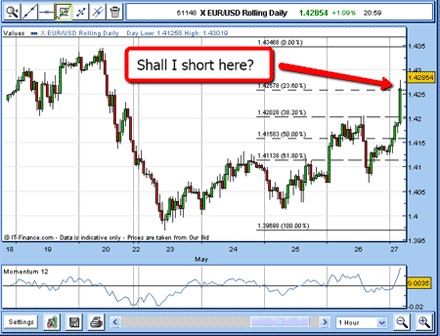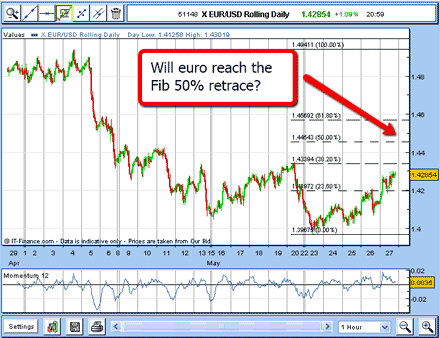It’s better to miss the odd profit than take a big loss
When spread betting, there will be times when cautious trading means you miss a trade. But safety is paramount, and it's better to forego the odd profit than take a big loss, says John C Burford.
Before we start, my apologies - there was an error in my last email on my euro trade, which I'm sure many of you spotted. On my second chart and in the copy, I referred to the 1.4200 level as the 50% level, whereas it was the 61.8% retrace. Sorry if that was confusing.
Last time, I described a short-term trade in the EUR/USD which was a wash (ie it broke even).
That was because I had moved my protective stop to break-even a few hours after entering my short trade at 1.4200.
MoneyWeek
Subscribe to MoneyWeek today and get your first six magazine issues absolutely FREE

Sign up to Money Morning
Don't miss the latest investment and personal finances news, market analysis, plus money-saving tips with our free twice-daily newsletter
Don't miss the latest investment and personal finances news, market analysis, plus money-saving tips with our free twice-daily newsletter
I felt I was justified in using my break-even rule since the market was going my way (down) off the Fibonacci 61.8% retrace level, and was trading more than 100 pips in profit.
Recall, this is my rough rule of thumb (when short-term trading against the minor trend) to determine when I move my protective stop (which was at 1.4235). I like to see a gain of 100 pips or so when trading the EUR/USD and the Dow, incidentally before I move my stop to break-even.
The number one rule look after your capital
Naturally, using this rule of thumb on some trades, I am going to be stopped out prematurely at break-even, and the market will carry on without me.
But I consider safety of equity to be paramount, and I am willing to forego a missed trade for the sake of keeping my account as intact as possible.
Other traders may be willing to give a trade more room, and that is fine. The way you handle your money management is your decision.
OK, so I was stopped out on the snap-back through the 1.4200 level early on May 27. The market was fast approaching the next Fibonacci level the 76.4% - at the 1.4260 area.

(Click on the chart for a larger version)
This would also be a natural place for the market to pause, at least.
Normally, I would place a short here, but because the long weekend was approaching, I decided against taking a short-term trade.
Very often, on the day before a long weekend, many big traders even up their positions and volatility can increase. You can expect close stops to be taken out in such volatile conditions. Better to play it safe.
As it happened, the market did rally to the 1.4300 level, which was 40 pips away from the 76.4% retrace.
If I had shorted at this level and placed my usual 35 pip stop, I would have been stopped out for a loss.

(Click on the chart for a larger version)
So that was a good decision!
I will now see what the charts look like in the early part of next week.
Don't jump in to a trade on a whim - use the charts to find entry points
I have a feeling this relief rally has more legs. Why do I say that?
When the euro was making its highs in the second part of April, everyone loved it bullish consensus data showed there were over 95% bulls.
With everyone on board, there was no more juice to move it higher, and so it reversed.
But the latest readings show only 65% bulls! There has been a marked swing towards the dollar in just a few days.
To me, this means that many traders have jumped on the bandwagon as the euro slid from 1.49 to 1.39 in May. That means there are many latecomers to the short side who could well be in trouble on a more substantial relief rally.
This could provide the fuel for a big 'short squeeze', before heading down again.
This is the way many traders lose. They see a new trend and have no established methodology for choosing when to enter they trade when they feel most bearish!
This is usually the very worst time to enter, as it usually coincides with a sharp snap-back. We call this 'Murphy's Law'.

(Click on the chart for a larger version)
We must always keep in mind that the major trend is still up. And the May swoon could just be a normal correction in an ongoing bull market.
Here is something to consider take a look at this chart:

(Click on the chart for a larger version)
I have drawn my tramlines and the Fibonacci levels.
The tramline third from the lowest is superb it passes right across three recent important highs and it is right up against it as I write (Friday May 27th's close).
The lowest one passes through the two important lows, and the one between also has a few exact touch-points.
I have drawn the upper one equidistant from the third-from-bottom and note how it will intersect the Fibonacci 50% level at 1.4450 very soon.
This is a very important level.
If the euro can rally early next week, taking it above the May 20 high at 1.4340, it should have enough oomph to challenge 1.4450, I feel.
You can bet that this will be an area I shall be focusing on.
And because the EUR/USD market is providing a wealth of great trades illustrating use of my trading methods, I plan to stay with this market for a while.
The summer promises to very eventful in the euro, as the sovereign debt crisis in the eurozone remains far from resolved.
NB: Don't miss my next trading insight. To receive all my spread betting blog posts by email, as soon as I've written them, just sign up here .
Get the latest financial news, insights and expert analysis from our award-winning MoneyWeek team, to help you understand what really matters when it comes to your finances.
John is is a British-born lapsed PhD physicist, who previously worked for Nasa on the Mars exploration team. He is a former commodity trading advisor with the US Commodities Futures Trading Commission, and worked in a boutique futures house in California in the 1980s.
He was a partner in one of the first futures newsletter advisory services, based in Washington DC, specialising in pork bellies and currencies. John is primarily a chart-reading trader, having cut his trading teeth in the days before PCs.
As well as his work in the financial world, he has launched, run and sold several 'real' businesses producing 'real' products.

